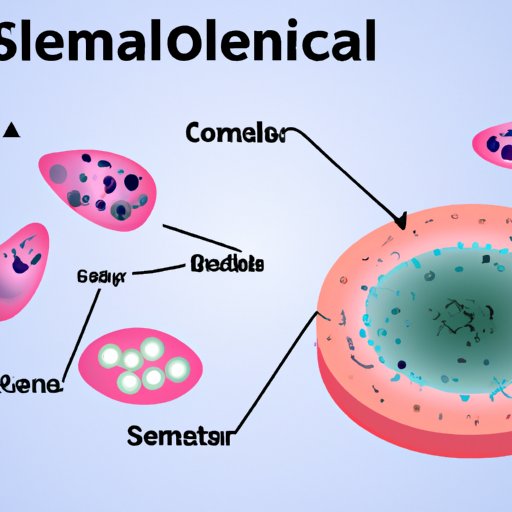Introduction
Somatic cells are the building blocks of the human body, responsible for carrying out essential functions such as growth and repair. Understanding the importance of somatic cells is crucial for maintaining overall health and preventing disease. The purpose of this article is to provide a beginner’s guide to somatic cells, exploring their different types, functions, roles in the body, and importance for medical research. This article is targeted towards individuals who are interested in learning more about basic biology and human anatomy.
A Beginner’s Guide to Understanding Somatic Cells
Somatic cells, otherwise known as body cells, make up the majority of cells in the human body, with the exception of sex cells. These cells operate to carry out various functions, including providing mechanical and structural support, transporting oxygen, digesting food, and defending against infection.
There are several types of somatic cells, differentiated by their unique roles in the body. These include:
- Skin cells
- Blood cells
- Nerve cells
- Muscle cells
- Bone cells
- Connective tissue cells
From Zygote to Adulthood: The Journey of a Somatic Cell in the Human Body
Every somatic cell begins as a single fertilized egg, or zygote, which undergoes multiple cell divisions and specializations to become a fully developed human being. This process, known as embryonic development, involves the formation of different germ layers, which develop into various tissues and organs. As somatic cells continue to differentiate and mature, they become committed to specialized functions and gain specific structures that enable them to carry out their roles in the body.
Somatic cells continue to change and adapt throughout different stages of development, from infancy through adulthood. For example, during puberty, sex cells develop, leading to further changes in the body. As individuals age, somatic cells may become less efficient in their functions, potentially leading to age-related diseases and disorders.
Exploring the Different Types of Somatic Cells and Their Unique Characteristics
Each type of somatic cell has unique characteristics that enable it to perform specific functions within the body. For example, skin cells are responsible for forming the protective barrier that shields the body from environmental toxins, while blood cells transport oxygen and nutrients throughout the body. Muscle cells, in turn, help to generate movement, while bone cells contribute to supporting the body’s frame and protecting vital organs.
Despite their differences, all somatic cells share certain features. They all contain a nucleus, which houses genetic material in the form of DNA. Additionally, they all contain cytoplasm, which contains organelles that help to carry out various functions.
How Somatic Cells Divide and Contribute to Growth, Repair, and Regeneration in the Body
Cell division and replication are crucial for somatic cells to contribute to the growth and repair of different tissues and organs. During cell division, a parent cell divides into two daughter cells that are genetically identical. This process, known as mitosis, allows cells to increase their numbers, leading to the formation of new tissues and organs.
In addition to mitosis, somatic cells can also contribute to tissue growth and repair through a process called regeneration. Regeneration enables damaged or lost tissues to be replaced by healthy cells, enabling the body to recover from injuries or illnesses. This process is particularly evident in the liver and skin, which have high regenerative capacity.
The Role of Somatic Cells in Health and Disease: A Closer Look
Somatic cells play a crucial role in preserving overall health and preventing disease. When somatic cells mutate or become damaged, they can lead to a range of diseases and disorders, including cancer, heart disease, and Alzheimer’s disease. Uncontrolled cell division, for example, can result in the formation of tumors, while mutations in the DNA may lead to impaired function.
Specialized somatic cells, such as immune cells, also play a crucial role in fighting off infection and protecting the body from foreign invaders. When these cells fail to function properly, the body becomes more susceptible to illnesses and infections.
Why Studying Somatic Cells is Crucial for Medical Advancements and Disease Treatments
Studying somatic cells is crucial for advancing medical research and developing new treatments and cures for diseases and disorders. By understanding the behavior of somatic cells, researchers can develop targeted therapies that can address specific problems within the body, such as cancer or metabolic disorders.
Recent advancements in somatic cell research, such as the development of induced pluripotent stem cells, hold great promise for the future of medicine. These cells can be used to generate healthy tissue and organs for transplantation, replacing damaged or diseased tissue with functioning ones.
Conclusion
Somatic cells are essential for carrying out vital functions in the human body, including growth, repair, and maintenance of overall health. By understanding the different types, functions, and roles that somatic cells play, we can gain a greater appreciation for the intricacies of human biology. As medical research continues to evolve and improve, it is likely that somatic cells will play an increasingly important role in the development of new treatments and cures.
If you are interested in learning more about the fascinating world of somatic cells, there are countless resources available, including scientific journals, biology textbooks, and educational websites.
